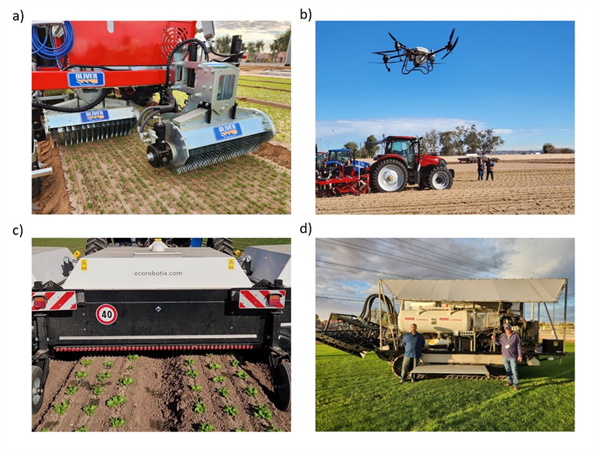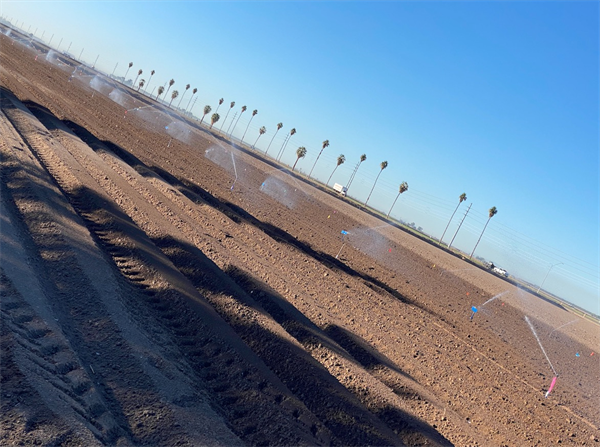
In arid and semi-arid regions, water is our first limiting factor in a crop production system, followed closely by bio-available nitrogen (N). Thus, our management of water and N are critically important to produce a healthy crop with good yields and quality.
Water and nutrient demands coincide with the fruiting cycle and efficient management of irrigation water and plant nutrients is enhanced by tracking crop development in the field. The use of heat units (HUs) with 86/55 oF upper and lower thresholds can be applied to warm season crops in the desert Southwest in relation to the thermal environmental impacts on the development of all crop systems (Brown, 1989), including chiles, (Figures 1 and 2).
Crop Phenology Relationship to Water and Nitrogen Demand
Phenological guidelines have been developed for many crops, including New Mexico type chiles (Soto-Ortiz and Silvertooth, 2007 and Silvertooth, et al, 2010; Figure 1). This phenological guideline can be used to identify or predict important stages of crop development that impact physiological requirements. For example, a phenological guideline can help identify stages of growth in relation to crop water use (consumptive use) and nutrient uptake patterns (Figure 3).
This information allows growers to improve the timing of water and N inputs to improve production efficiency. For some crops or production situations HU based phenological guidelines can be used to project critical dates such as harvest or crop termination. Many other applications related to crop management (e.g., pest management) can be derived from a better understanding of crop growth and development patterns.

Figure 1. Typical relationship between the rate of plant growth and development
and temperature. Growth and development ceases when temperatures decline
below the lower temperature threshold (A) or increase above the upper
temperature threshold (C). Growth and development increases rapidly when
temperatures fall between the lower and upper temperature thresholds (B).

Figure 2. Basic phenological guideline for irrigated New Mexico-type chiles.
References
Brown, P. W. 1989. Heat units. Bull. 8915, Univ. of Arizona Cooperative Extension, College of Ag., Tucson, AZ.
Silvertooth, J.C., P.W. Brown, and S. Walker. 2010. Crop Growth and Development for Irrigated Chile (Capsicum annuum). University of Arizona Cooperative Extension Bulletin No. AZ 1529
Soto-Ortiz, R. and J.C. Silvertooth. 2007. A Crop Phenology Model for Irrigated New Mexico Chile (Capsicum annuum L.) The 2007 Vegetable Report. Jan 08:104-122.
Hi, I’m Chris, and I’m thrilled to be stepping into the role of extension associate for plant pathology through The University of Arizona Cooperative Extension in Yuma County. I recently earned my Ph.D. in plant pathology from Purdue University in Indiana where my research focused on soybean seedling disease caused by Fusarium and Pythium. There, I discovered and characterized some of the first genetic resources available for improving innate host resistance and genetic control to two major pathogens causing this disease in soybean across the Midwest.
I was originally born and raised in Phoenix, so coming back to Arizona and getting the chance to apply my education while helping the community I was shaped by is a dream come true. I have a passion for plant disease research, especially when it comes to exploring how plant-pathogen interactions and genetics can be used to develop practical, empirically based disease control strategies. Let’s face it, fungicide resistance continues to emerge, yesterday’s resistant varieties grow more vulnerable every season, and the battle against plant pathogens in our fields is ongoing. But I firmly believe that when the enemy evolves, so can we.
To that end I am proud to be establishing my research program in Yuma where I will remain dedicated to improving the agricultural community’s disease management options and tackling crop health challenges. I am based out of the Yuma Agricultural Center and will continue to run the plant health diagnostic clinic located there.
Please drop off or send disease samples for diagnosis to:
Yuma Plant Health Clinic
6425 W 8th Street
Yuma, AZ 85364
If you are shipping samples, please remember to include the USDA APHIS permit for moving plant samples.
You can contact me at:
Email: cdetranaltes@arizona.edu
Cell: 602-689-7328
Office: 928-782-5879
At the 2024 Southwest Ag Summit Field Demo a couple of weeks ago, many of the latest technologies were demonstrated in the field. Most were related to pest control. Several of the technologies demonstrated or on display at the event are brand new to the Yuma, AZ area. The new technologies presented included an implement designed for cultivating high density crops (Fig. 1a), a field scale drone sprayer (10.6 gal) (Fig. 1b), a high precision spot sprayer (Fig. 1c) and a self-propelled machine that disinfests soil prior to planting using steam. Updated versions of laser weeders, camera-guided cultivators and smart, automated in-row weeding machines (mechanical) were also demonstrated. Over the next several years, it will be interesting to watch the technologies in this space evolve further and become integrated into our cropping systems.

Fig. 1. New pest control technologies demonstrated/on display at the 2024
Southwest Ag Summit Field Demo included a) Oliver1 high density cultivator b)
DJI Agrospray T40 drone sprayer c) Ecorobotix ARA high precision spot sprayer
and d) UC Davis/University of Arizona self-propelled steam applicator for
disinfesting soil prior to planting.
[1] Reference to a product or company is for specific information only and does not endorse or recommend that product or company to the exclusion of others that may be suitable.
The Yuma IPM Team has received requests for herbicide efficacy data generated locally for Onion and Broccoli.
We are currently doing some evaluations for direct seeded broccoli. Some of the treatments suggested by PCAs and growers are Devrinol DF XT at the rate of 1.0 and 2.0 lb, also Devrinol 2-XT at the rate of 1.0 and 2.0 qt. Additional preemergence herbicides included in the trials are Prefar 6 qt, Trifluralin 1.5 pt. Other treatments included are Goal Tender and Prowl with a directed application at 3-5 leaves. In a separate broccoli test we are looking at different incorporation timings of Devrinol due to some stunting issues reported. Our trial includes 12, 24, 36 hour sprinkler irrigation incorporation times for the liquid and dry formulations. Phytotoxicity will be evaluated and reported to you in this newsletter and University of Arizona Workshops.
For onions we established trials including treatments suggested such as Ethotron SC at 32 fl oz to a fine soil. Also included Prefar, Dual Magnum and Treflan preemergence. We will compare with Outlook plus Prowl and Goal Tender at 3 leaf stage.
Additionally, Corteva Agriscience is also focused in providing some options for weed control in both broccoli and onions. Some of their products been evaluated at the Agricultural Center are Rinskor (Hulk) and Enversa at post and preemergence.
We thank you for your treatment suggestions, which are incredibly helpful for designing the experiments we are conducting. We are looking forward to sharing the results with you.

This time of year, John would often highlight Lepidopteran pests in the field and remind us of the importance of rotating insecticide modes of action. With worm pressure present in local crops, it’s a good time to revisit resistance management practices and ensure we’re protecting the effectiveness of these tools for seasons to come. For detailed guidelines, see Insecticide Resistance Management for Beet Armyworm, Cabbage Looper, and Diamondback Moth in Desert Produce Crops .
VegIPM Update Vol. 16, Num. 20
Oct. 1, 2025
Results of pheromone and sticky trap catches below!!
Corn earworm: CEW moth counts declined across all traps from last collection; average for this time of year.
Beet armyworm: BAW moth increased over the last two weeks; below average for this early produce season.
Cabbage looper: Cabbage looper counts increased in the last two collections; below average for mid-late September.
Diamondback moth: a few DBM moths were caught in the traps; consistent with previous years.
Whitefly: Adult movement decreased in most locations over the last two weeks, about average for this time of year.
Thrips: Thrips adult activity increased over the last two collections, typical for late September.
Aphids: Aphid movement absent so far; anticipate activity to pick up when winds begin blowing from N-NW.
Leafminers: Adult activity increased over the last two weeks, about average for this time of year.







